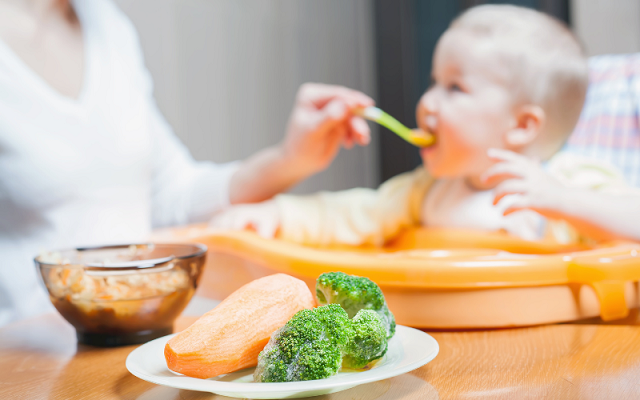The fetus grows in the mother's womb, nourished through the umbilical cord, and then continues its growth by consuming breast milk., when his/her mom breastfeeds him/her.
During the 9 months of pregnancy, and then during the few months of exclusive breastfeeding, the baby grows solely thanks to maternal contributions! It's the magic of life...
Then comes a major stage, diversification. The child will begin to eat something other than infant milk, thus opening the door to new food discoveries.
The Right Time: When to Start Diversification ?
The right time to start introducing solid foods to a child varies for each child.
It is important to take into account:
- the development of the child,
- of its digestive capabilities,
- and his interest in food.
Official recommendations change regularly, and practices vary around the world, but generally, the baby starts diversification around middle of his/her 1st year of life, that is around the 6 months.
It is recommended not to start diversification before the baby is 4 months old.
Take into account the signs which indicate that The child is ready to eat. It seems like your message is incomplete. Could you please provide the text you would like translated from French to English?
- "La" motor skills : suggest diversification when the child begins to sit up on their own, according to their motor skills.
- The baby no longer presents the protrusion reflex of the tongue, when the baby pushes the food out with their tongue and automatically spits it out,
- Take into account the interest from the baby for food: does he reach out when you eat, or even cry to ask for it, does he try to grab your fork and your food ?
Diversification is one of the important stages in a child's life, which can begin gradually taking into account these signs, their reactions, and the baby's growing interest.
Steps and Timeline of Diversification
Once again, the recommendations vary and all kinds of advice can come flooding in !
Trust yourself and trust your baby.
Learn to listen to them, observe the signs of interest and reactions from your child to guide you.
We usually start diversification by giving him a few spoonfuls of fruit and vegetable puree, , often in small quantities. The first purees are sometimes smooth and then with soft chunks.
Then we gradually move on to solid food. Solid foods are introduced one at a time, gently.
For breastfed babies Sure, please provide the text you would like me to translate.
The idea is that the baby will continue to receive numerous nutrients through milk, especially if breastfed. Nutritional intake is gradually transferred and covered by solid foods, but breast milk still covers more than 50% of the child's energy needs. If the mother is not deficient, breast milk is rich in nutrients as well as antibodies. Thus, the WHO recommends that breast milk be the major food source. until about 1 year, before possibly moving on to growth milk.
Diversification is therefore, initially, above all an opportunity to discovery, experience, openness to the world.
It will take several months, or even several years, for the digestive system to develop. Gradually, food will increasingly meet the child's energy needs. This is an opportunity to offer the best foods "to your child, to choose" fresh products, ", of" quality, preferably sourced from organic or sustainable agriculture.
Each family will make its own dietary choices—omnivore, vegetarian, vegan, raw food, flexible... And the baby, at first, will generally follow the family's lead by receiving safe meals adapted to their stage of development.
Raw food for babies ?
It is also possible to offer a new exploration of raw, unprocessed foods, presented as close to their natural state as possible, for baby's meals.
We can make adaptations, blend or cook certain foods to reduce the risk of choking, and sometimes just lightly cook them.
One can propose:
- of thecoconut water and homemade plant-based milk
- the introduction of foods such as whole ripe fruits and vegetables, grated, cut, blended, in smoothies, pureed, in soups, or lightly cooked to avoid risks (carrot, apple).
- vegetable and fruit juices
- sprouted seeds, seaweed
- We will introduce oilseeds, nuts, and seeds, as well as allergenic foods, at a later stage to take into account food allergies.
I intentionally do not provide a schedule because recommendations vary, and it seems important to me to adapt and personalize the diversification for each child and according to each family.
One can go further with a naturopediatric consultation to tailor advice according to the child's constitution, parental history, and the baby's preferences.
Managing Reactions and Allergies
It is important to observe the child's reactions to the introduction of a new food:
Digestive reactions: diarrhea, constipation, color, texture, odor of stool, presence of pieces, vomiting, regurgitation, abdominal pain...
Skin reactions: pimples, redness, patches, eczema, hives, itching...
ENT reactions: mucus, colds, respiratory disorders...
Other reactions: sleep disturbances, joy of living, vitality, mood, crying, screaming, restlessness, wriggling...
Propose new foods instead. during the day in the evening, in order to observe possible allergic reactions, especially in cases of an allergenic predisposition.
Attention, the child may show signs of intolerance without testing positive for allergies.
Take into account your observations and your child's reactions, even if the allergy tests are negative.
A food that causes problems today may very well be tolerated a little later.
The Role of Diversification in Sensory Development
The senses are in turmoil during the first months of life.
Everything is new for the baby !
The senses allow him to discover the world and the stimuli. sensory participate in the healthy development of the child.
The first meals are not so much about "feeding" the child nutritionally, but rather about sensory experiences.
The view Sure, please provide the text you would like to be translated from French to English. Like us, babies eat with their eyes before their mouths. Offer a diet based on natural and simple products., allows a natural connection of the child through their senses. The baby generally follows their instinct and will be able to choose the type of food according to their own needs.
The sense of smell Sure, please provide the text you would like to be translated from French to English. By offering natural foods, we limit olfactory disturbances. Initially, avoid vegetables with spices and spices in general, to allow the child to connect with the natural smells and flavors of the foods. When they are very young, let them smell the fruits and vegetables even before eating them.
Touch Sure, please provide the text you would like me to translate. By allowing the child to touch and handle whole foods, they can develop their motor skills, grasping ability, and discover the different textures, temperatures, and moisture levels that vary with each food.
Child-led weaning, CLW, emphasizes this approach. baby's autonomy .
Hearing Sure, please provide the text you would like to be translated from French to English. Cooking and eating generate sounds: the song of cutting and peeling vegetables, the noise of meal preparation, the sound of chewing, cutlery, plates, etc. These are noises that become familiar to the child.
Eating in a calm, pleasant, and serene atmosphere promotes a balanced environment that is beneficial for the whole family.
The taste Sure, please provide the text you would like to be translated from French to English. The baby discovers the world of flavors in the mother's womb through the amniotic fluid. Then, if the baby is breastfed, the range of flavors expands through the taste of breast milk, which constantly changes, influenced by what the mother eats.
Food diversification greatly expands taste experiences, particularly with the introduction of new textures, aromas, and flavors, seasonal menus, and combinations of foods, thus stimulating the baby's taste buds.
In the early stages, it doesn't matter much if the baby consumes large quantities. It's not a problem if they experiment and "play" with the food. The most important thing is that they can create a healthy and balanced relationship with food, to avoid stress, compulsions, fears, emotional pressure, etc., while gradually developing their chewing movements.
Food diversification is an opportunity to create a pleasant and serene atmosphere, allowing the child to develop a healthy relationship with food. By avoiding pressure for the child to eat certain amounts, finish their plate, etc., we promote self-confidence, a good relationship with food, and above all, respect for the child, their needs, and their instincts. These are good reasons to adopt a relaxed and open approach when introducing solid foods.
Child-Led Diversification
What is DME? DME (Baby-Led Weaning) is giving the most ofautonomy "and of" respect to the baby during the first meals.
The idea is to offer several foods in pieces or whole and to let the child choose, , "to bring to the mouth alone", eating with one's fingers and not a baby meal in the form of smooth puree given by another person with a teaspoon inserted into their mouth.
On the organizational side It seems like your message is incomplete. Could you please provide the text you would like translated from French to English?
- Put on a bib
- Protect the soil
- Choosing foods or methods suitable for the baby's motor skills
- Avoid the risk of choking (pieces of raw apple, pieces of raw carrot...)
- Cut very finely, grate, cook risky foods
- You can start by introducing vegetables, for example, by offering a thick vegetable puree, possibly with small pieces, and giving the spoon to the child so they can bring it to their mouth on their own.
DME can be practiced regularly or occasionally.
It is possible to practice BLW at home and not practice it when the child is being cared for, for example.
No stress, no dogma. The child will adapt and will be able to express their needs if necessary.
DME allows It seems like your message is incomplete. Could you please provide the text you would like translated from French to English?
- "that the baby discovers by himself"
- that the child manages his/her hunger "and his/her/its" satiety
- that he develops his fine motor skills
- that he develops his autonomy "and feels" respected
- that he uses all his meaning
- and many others that you will discover by practicing...
Diversification and Baby's Sleep
Diet can influence the sleep of babies, just as it does for adults. It is quite common to think that "stuffing" the child before bedtime will help them sleep better, or even, hopefully, sleep through the night!
Observe your own sleep after a large meal and after a frugal meal, guided by your real needs... Again, it is not necessary to overfeed the baby, but rather to provide them with trust "and of" respect his needs by letting him choose the amount he will eat without resorting to all sorts of strategies to increase the quantity of food consumed...
Avoid introducing allergens or new foods in the evening to better observe possible reactions. Provide attention and physical contact during the day and evening, establish a bedtime ritual suited to your little one to meet their emotional needs, reassure them, and gently help them sleep through the night.
Easy Recipes for Beginners
Here are some menu ideas to start with:
Plant-based milk: Test homemade plant-based milk to offer fresh, nutritious, and delicious milk.
Test the incredible coconut milk : Open a fresh coconut, pour the water and the pulp into the blender, blend.
For the little ones:
Fruit puree: Choose a seasonal fruit and mash or blend it to adjust and vary the textures. Follow the seasons to discover a wide variety of fresh fruits to incorporate into your baby's diet. A well-ripened fruit can simply be mashed with a fork (banana, pear, mango), while a hard fruit can be blended or grated (apple).
We start with a single fruit, then we can gradually offer mixes and combinations, add nut butters, mix fresh fruits and dried fruits, and add a pinch of spirulina "or of" pollen for example.
For the DME:
Varied and colorful plate: Offer different foods of various colors, different textures, both raw and cooked, and let the child eat on their own, bringing the food to their mouth, tasting, crushing, discovering, and choosing what they eat and the quantity.
Plate 1: 1 slice of raw cucumber, 1 lettuce leaf, some sprouted seeds, 1 piece of banana, 3 slices of orange, 1 carrot, and 1 piece of steamed cauliflower. Pour a little oil (olive – camelina).
Plate 2: A few very thin slices of ripe pears, 1 piece of grated apple, a few slices of steamed carrots, 1 piece of cooked leek, 1 piece of seaweed, 1 endive leaf, 1 piece of peeled avocado. Pour a bit of oil (olive – camelina).
For the older ones:
Green salad, grated carrot, raw avocado, cucumber, cooked broccoli, Swiss chard, leek, seaweed, sprouted seeds, lacto-fermented vegetables, olive oil + camelina or rapeseed oil.
Tips for calm and enjoyable meals
Creating a good atmosphere during meals allows the child to be calm and develop a healthy relationship with food.
- Release the pressure and trust your child. Work on yourself.
- Propose simple foods and do the same for the whole family if possible, prioritizing safe foods for the baby that are appropriate for their age and digestive abilities.
- Prepare the space around the baby: a long-sleeved bib, a trash bag on the floor, or a plastic mat to make cleaning easy.
- Place the baby in a high chair near you or on your lap. Never leave them alone.
- Sharing meals with baby to interact, comment, observe
- Create a calm and pleasant atmosphere during meals
- Give the child time
- Encourage child-led diversification when possible and if you are comfortable with the concept.
- When it's not possible, make adaptations! Sometimes you can do baby-led weaning and occasionally offer spoon-fed purees.
Be flexible to stay calm.
To summarizeIt seems like your message is incomplete. Could you please provide the text you would like translated from French to English?
- Observe your baby
- Do not rush or stress yourself.
- Conduct a slow and gradual diversification
- Use the DME when possible
- Propose natural, nutrient-rich foods
- If it suits you and is possible, continue breastfeeding.
- Have a naturopathy consultation, especially if you are following a specific diet.





















